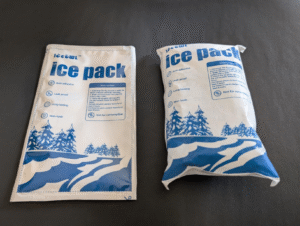Dry ice packs are essential for maintaining sub-zero temperatures during shipping and storage, especially for perishable goods. But how long do they last? The longevity of dry ice depends on several factors like the amount used, the quality of the container, y condiciones ambientales. Understanding these elements can help you use dry ice more efficiently for your cold chain logistics and preservation needs.

-
How long does a dry ice pack last in different environments?
-
What factors affect its lifespan?
-
How can you store and handle dry ice to extend its longevity?
-
What are the best practices for using dry ice in shipping and storage?
How Long Does a Dry Ice Pack Last?
Típicamente, a dry ice pack lasts between 18 a 48 horas. Sin embargo, the exact duration depends on key variables:
-
Quantity of dry ice: Larger amounts of dry ice sublimate slower.
-
Quality of insulation: High-quality insulation prolongs the cooling duration.
-
Ambient temperature: The warmer the environment, the quicker the sublimation.
Key Factors That Affect Dry Ice Longevity
Cantidad de hielo seco
The more dry ice you use, the longer it will last. Larger quantities take longer to sublimate because there’s more solid carbon dioxide available to transition into gas. Por ejemplo, 10 pounds of dry ice may last around 24 horas, mientras 20 pounds could last up to 72 hours in the right conditions.
Quality of Insulation
Insulation is crucial in extending dry ice’s lifespan. The better the container’s insulation, the less heat enters the package. Styrofoam coolers or vacuum-sealed containers are ideal for extending the cooling duration. Poor insulation accelerates sublimation, reduciendo el tiempo de enfriamiento.
Ambient Temperature
Dry ice sublimates faster in warmer temperatures. If the surrounding environment is hot, the dry ice will evaporate rapidly. To slow down the sublimation process, it’s essential to store dry ice in cool, dry locations away from direct sunlight or heat sources.
Type of Container
The type of container used can significantly impact how long dry ice lasts. Insulated containers reduce heat transfer, helping dry ice stay solid longer. Airtight containers, sin embargo, pose safety risks as the buildup of carbon dioxide gas can cause them to burst.
Maximizing Dry Ice Longevity
Even with external factors at play, several steps can help you maximize the life of dry ice packs:
-
Use Insulated Containers
Insulated containers, such as Styrofoam boxes, slow down heat transfer and extend dry ice’s effectiveness. High-performance materials for insulation can keep dry ice cool for longer, which is crucial in cold chain logistics. -
Minimize Air Exposure
The more dry ice is exposed to air, the faster it sublimates. To prevent unnecessary sublimation, avoid opening the container frequently. Opt for containers that allow controlled ventilation, ensuring carbon dioxide gas can escape while limiting warm air intake. -
Store Dry Ice in Cool, Dry Areas
Dry ice lasts longer when stored in a cool, dry environment. Ensure that the storage space is free from heat sources and direct sunlight. Si es posible, keep it in a temperature-controlled setting. -
Choose Dry Ice Blocks Over Pellets
Dry ice blocks last longer than pellets. Blocks have less surface area for sublimation, meaning they sublimate slower. If you’re shipping items that need to stay cool for longer, using blocks is a more efficient choice.
Ejemplo de la vida real:
When transporting medical supplies, como las vacunas, it is critical to keep them within a specific temperature range. Using dry ice blocks inside insulated containers can maintain the necessary temperatures for up to 48 horas, ensuring the products remain viable for use.
When Should You Replace Dry Ice in a Package?
The lifespan of dry ice in a package is typically 18 a 48 horas, but this can vary depending on the conditions. For long shipments, it is essential to monitor and replace the dry ice regularly to ensure the integrity of the items being transported.
Time-Based Replacement
Dry ice needs to be replaced after its cooling effect diminishes, which typically happens after 18-48 horas. Depending on your shipping needs, it may be necessary to replace dry ice throughout the journey to maintain the desired temperature.
Sublimation Monitoring
Once dry ice has fully sublimated (transformed from a solid to gas), it can no longer provide cooling. Keep an eye on your dry ice and replace it when needed to ensure that the temperature-sensitive products stay within the required range.
Why Is Dry Ice Preferred Over Regular Ice?
Dry ice is superior to regular ice in many applications, especially when it comes to long-term cooling and preservation at sub-zero temperatures. Here are some reasons why:
| Característica | Hielo seco | Regular Ice |
|---|---|---|
| Temperatura | -78.5°C (-109.3°F) | 0°C (32°F) |
| Duración del enfriamiento | 18-48 horas | 4-6 horas |
| Residue | Sublimates into gas, no residue | Melts into water |
| Ideal Use | Long-duration cooling | Short-term cooling |
Key Advantages of Dry Ice:
-
Longer Duration: Dry ice lasts significantly longer than regular ice, which is essential for shipments that require extended cooling times.
-
No Residue: A diferencia del hielo normal, which creates water residue, dry ice sublimates directly into gas, leaving no mess behind. This is especially useful when shipping sensitive goods, such as electronics or pharmaceuticals.
2025 Dry Ice Trends and Innovations
The dry ice industry is continuously evolving. Several trends are emerging in 2025 to enhance its efficiency and sustainability.
Latest Advancements in Dry Ice Technology
-
Improved Insulation Materials: New high-performance materials help reduce heat transfer, extending the cooling duration during transport and storage.
-
Sostenibilidad: The demand for energy-efficient and environmentally friendly methods of producing dry ice is growing, making it a more sustainable choice for cold chain logistics.
-
Automated Cold Chain Management: Automation and IoT technologies allow companies to monitor and adjust temperatures in real-time, enhancing the effectiveness of dry ice in long-duration shipments.
Ideas del mercado
With the increasing demand for temperature-sensitive goods, industries such as pharmaceuticals, biotecnología, and food delivery are increasingly relying on dry ice. The continued growth of cold chain logistics highlights the importance of dry ice in temperature-controlled shipping.
Common Questions About Dry Ice
How long does a dry ice pack last in a cooler?
Dry ice typically lasts between 18 y 48 hours in a well-insulated cooler, depending on the amount of dry ice and the quality of the insulation.
Can dry ice last more than 48 horas?
Sí, but in most cases, dry ice lasts for up to 48 horas. If a longer duration is needed, replenishment may be necessary, or specialized containers designed for extended cooling can be used.
How can I slow down dry ice sublimation?
Use high-quality insulation, store dry ice in cool environments, and limit the frequency of container openings to slow down the sublimation process.
Conclusión y recomendaciones
Dry ice is a vital tool in maintaining sub-zero temperatures during shipping and storage. Its lifespan can vary between 18 a 48 horas, depending on factors like the amount of dry ice, the type of container, y la temperatura circundante. By following best practices such as using insulated containers, minimizing air exposure, and choosing larger blocks of dry ice, you can maximize its cooling efficiency.
Siguientes pasos:
-
For Businesses: Upgrade your cold chain solutions with improved insulation and larger quantities of dry ice for longer shipments.
-
For Consumers: Regularly monitor dry ice and replace it as needed to ensure items remain at the proper temperature during transport.
Acerca de Tempk
Tempk is a leading provider of cold chain solutions, specializing in high-quality dry ice products for industries such as pharmaceuticals, conservación de alimentos, and research. We ensure that your temperature-sensitive goods are safely transported and delivered on time.
Contact Us Today: Ready to optimize your cold chain logistics? Get in touch with our expert team for tailored solutions!























